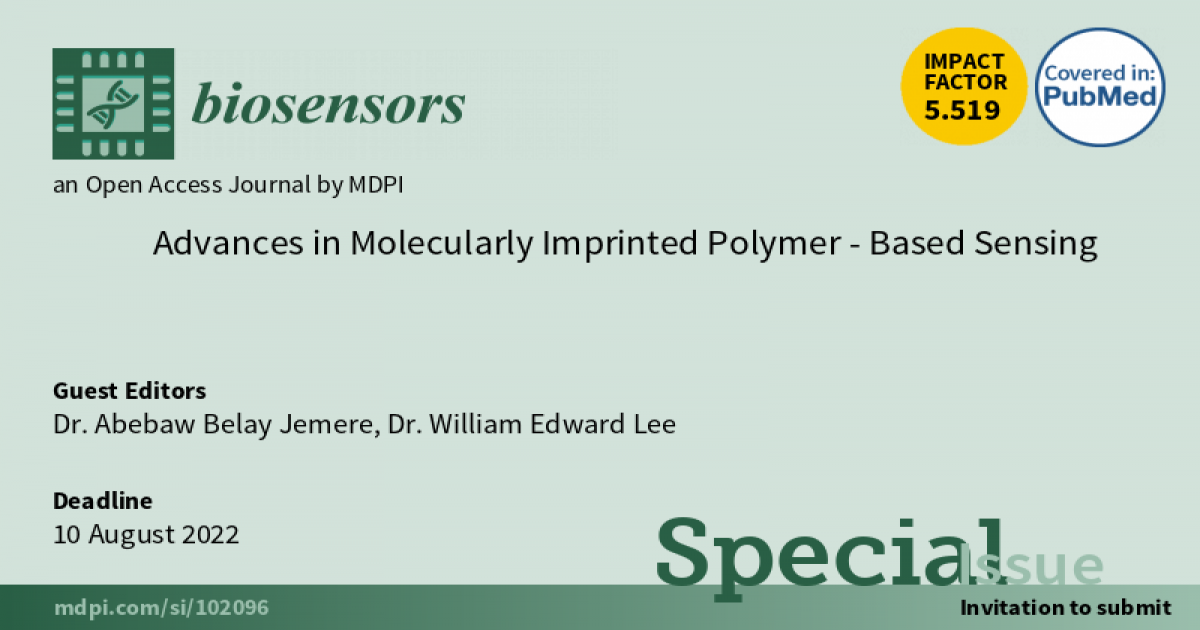Advances in Molecularly Imprinted Polymer-Based Sensing
A special issue of Biosensors (ISSN 2079-6374). This special issue belongs to the section "Biosensor Materials".
Deadline for manuscript submissions: closed (10 August 2022) | Viewed by 6023

Special Issue Editors
Interests: microfluidics; microfabrication; electrochemical sensors; biosensors; nanotechnology; nanomaterials and their applications in sensing; immunoassays; molecularly imprinted polymers
Interests: electrochemical sensors; biosensors; chemical sensors; microfluidics; nanotechnology; molecularly imprinted polymers; molecular recognition; receptor-ligand binding; signal transduction
Special Issue Information
Dear Colleagues,
Molecularly imprinted polymers (MIP) offer cost-effective, reusable and highly stable recognition materials which are alternatives to natural receptors. Combining MIPs with conventional detection methods, researchers have developed highly selective, sensitive and robust detection strategies for a wide range of analytes, such as small molecules, biomarkers, even proteins and microorganisms. Due to the ease of adaptation of MIPs in sensors, practical applications have increased in various fields over the past decade.
For this Special Issue, we seek original research and review articles that describe advances and future trends in MIP-based affinity sensors for a wide range of applications (e.g., medical, environmental, industrial, food, and security). Original papers that describe novel methods of MIP preparation or novel applications of MIP sensors are welcome. Reviews should provide a critical evaluation of the current state-of-the-art of, for example, the use of MIP for the fabrication of a particular type of sensor (i.e., electrochemical, optical, acoustic, or piezoelectric). Critical reviews on the current development of MIP sensors for a particular application (e.g., medical, environmental, industrial, food, and security) are also of interest.
Dr. Abebaw Belay Jemere
Dr. William Edward Lee
Guest Editors
Manuscript Submission Information
Manuscripts should be submitted online at www.mdpi.com by registering and logging in to this website. Once you are registered, click here to go to the submission form. Manuscripts can be submitted until the deadline. All submissions that pass pre-check are peer-reviewed. Accepted papers will be published continuously in the journal (as soon as accepted) and will be listed together on the special issue website. Research articles, review articles as well as short communications are invited. For planned papers, a title and short abstract (about 100 words) can be sent to the Editorial Office for announcement on this website.
Submitted manuscripts should not have been published previously, nor be under consideration for publication elsewhere (except conference proceedings papers). All manuscripts are thoroughly refereed through a single-blind peer-review process. A guide for authors and other relevant information for submission of manuscripts is available on the Instructions for Authors page. Biosensors is an international peer-reviewed open access monthly journal published by MDPI.
Please visit the Instructions for Authors page before submitting a manuscript. The Article Processing Charge (APC) for publication in this open access journal is 2200 CHF (Swiss Francs). Submitted papers should be well formatted and use good English. Authors may use MDPI's English editing service prior to publication or during author revisions.
Keywords
- molecular imprinting;
- molecular recognition
- sensing
- biosensing
- food and agriculture safety
- security
- diagnostics
- environmental screening
Benefits of Publishing in a Special Issue
- Ease of navigation: Grouping papers by topic helps scholars navigate broad scope journals more efficiently.
- Greater discoverability: Special Issues support the reach and impact of scientific research. Articles in Special Issues are more discoverable and cited more frequently.
- Expansion of research network: Special Issues facilitate connections among authors, fostering scientific collaborations.
- External promotion: Articles in Special Issues are often promoted through the journal's social media, increasing their visibility.
- Reprint: MDPI Books provides the opportunity to republish successful Special Issues in book format, both online and in print.
Further information on MDPI's Special Issue policies can be found here.







